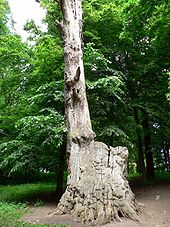Raudonė
| Raudonė | ||
|
||
| State : |
|
|
| District : | Tauragė | |
| Rajong municipality : | Jurbarkas | |
| Office : | Raudonė | |
| Coordinates : | 55 ° 6 ' N , 23 ° 8' E | |
| Inhabitants (place) : | 510 (2011) | |
| Time zone : | EET (UTC + 2) | |
| Telephone code : | (+370) 447 | |
| Postal code : | 74057 | |
| Status: | Town, center of a part of the municipality |
|
|
|
||
Raudonė (German outdated Raudonn ) is a small town (miestelis) on the banks of the Memel River in Lithuania . He is the center of the country office of the same name Rajongemeinde Jurbarkas in tauragė county . In 2011 the place had 510 inhabitants. Raudonė is best known for its chateau and park.
Geographical location
Raudonė is located near the southwestern border with Kaliningrad Oblast , a Russian exclave on the Baltic Sea between Lithuania and Poland , formerly part of East Prussia . The distance to the border is about 30 kilometers. The western district town of Jurbarkas is not quite 25 kilometers away. Raudonė has in common with her the northern location on the Memel, which at the same time forms the southern district and district border. The district capital, Tauragė , is 58 kilometers northwest of Raudonė.
history
lock
Raudonė was first mentioned in the 16th century as the estate of the Polish King Sigismund II August . He sold this property to the Prussian timber merchant Hieronymus Krispin-Kirschenstein around 1580 . He and his son built the first castle in the Renaissance style.
The castle owes its present appearance above all to the renovations under the supervision of Count Subov's daughter, Sofia Kaissarowa, in the neo-Gothic style from 1861 to 1877. The last noble owners were the granddaughter Sofia Waxell and her Portuguese husband José Carlos de Faria e Castro.
After looting in the First World War , the descendant de Faria e Castro was in debt and auctioned the castle in 1934. After protests, the Lithuanian National Bank left it to the Ministry of Education, which carried out restoration work in 1936. In 1944 the Wehrmacht blew up the main tower of the castle, which was later rebuilt and is now open to visitors. The main building has housed a middle school since 1947, which was demoted to a primary school in 2003.
park
The spacious park in the form of an English landscape park was essentially created by the Russian nobleman Platon Subow , who had bought the property at the beginning of the 19th century. The two reservoirs and the mill date from this time. Numerous old trees line the paths, including one of the oldest oaks in Lithuania, the Gediminas oak (dead since 1997). According to legend, the Grand Duke Gediminas ate his last meal here before he was fatally wounded during the siege of the Bayerburg held by the Teutonic Order in December 1341.
literature
- William Urban: The Teutonic Knights: A Military History. Greenhill Books, London 2003, p. 133. ISBN 1-85367-535-0
Web links
- Raudonės pilis (Lithuanian)
- Raudonės pilis parkas (Lithuanian)
- Jurbarkas region (English)




